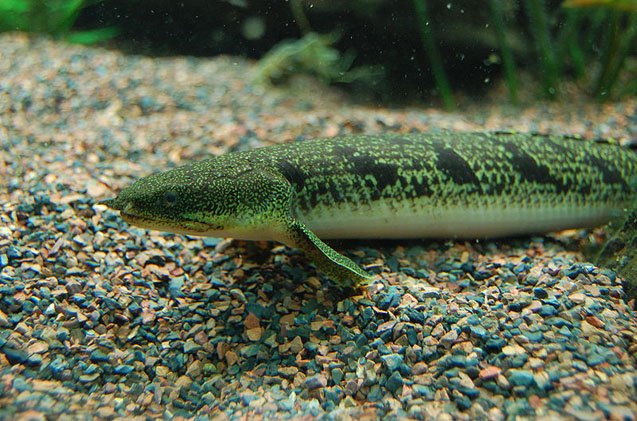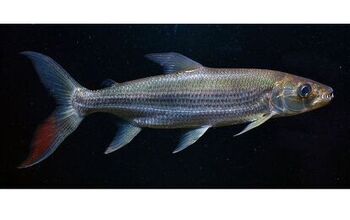Bichirs


About Bichirs
Bichirs are a species of primitive freshwater fish. They are characterized by their long, eel-like bodies and unique dorsal finlets. These spiny finlets vary in number from 7- 18 and have double edged tips. The rest of the bichir fins are spineless and are made of soft rays. Their body is covered in thick, bone-like scales which along with its fleshy pectoral fins give it its prehistoric appearance. Most bichir are large in size and can reach up to 38 inches in length.
There are a lot of unique traits this unusual fish breed boasts. Bichirs are capable of breathing surface air through a specialized swim bladder and can use their powerful pectoral fins to crawl over short distances over land. Owing to this, they will need a large aquarium with a lid, as they’re prone to slinking out of the tank.
These freshwater fishes are imposing nocturnal carnivores, and as such, they will need to be housed properly. Choose their tankmates carefully and make sure that they’re only housed with compatible roommates- in other words, those fishes that won’t become their food or eat all of the food.
Bichirs are certainly an impressive breed, with a distinct ancient appearance that appeals to many aquaristics enthusiasts. Their prehistoric looks also earned some of the varieties appropriate common names, such as the dinosaur eel, dinosaur Bichir, swamp dragon, or dragon fish. If you are looking for an unusual-looking addition to your freshwater tank and think Bichirs are a perfect choice, read on to see if this breed is compatible with your set up and its inhabitants.
Bichirs are a species of primitive freshwater fish. They are characterized by their long, eel-like bodies and unique dorsal finlets.
All species of Bichir are native to tropical Africa and the Nile River system, extending their habitat to India as well. They live in muddy waters and hide in vegetation to hunt their prey.
Experts claim that Polypteridae, which is the scientific name for this fish family, first appeared in the last period of the Mesozoic era. This means that these ray-finned fishes don’t only look archaic, but they actually are ancient- their family has been around for about 60 million years.
In addition to their thriving populations in the wild, Bichirs are also bred in captivity and make a popular aquarium fish.
If you want a flashy fish whose vibrant colors will brighten your tank’s interior, this freshwater fish breed is not for you. Bichirs are often dull colored in shades of brown, grey and black. There are some minor exceptions to this rule, though, with varieties such as Ornate Bichir. The black and yellow intricate patterning might not be as exotic as the colorful scales of Discus or Flowerhorn, but it is far more impressive than beige and grey tones of other Bichirs.
To no one surprise, the Bichir fishes are exceptionally hardy and adaptable. These freshwater dwellers are not overly demanding and won’t need much fussing over to thrive in most set up. However, there are some important requirements to take into consideration if you want to make sure this archaic fish lives long and healthy in your care. In captivity, Bichirs can live for up to 10 years if their needs are met.
All Bichirs are large and will need a size-appropriate aquarium to live in. As a rule of thumb, the tank shouldn’t be less than 50 gallons. When it comes to pH and general quality of water, these fishes are not finicky and won’t mind if they’re swimming around in plain tap water. Just be mindful of their tropical habitats and make sure that the water temperatures are between 25 and 29 degrees Celsius.
Adult bichir are primarily bottom dwellers but will often shoot up towards the surface to breathe in air. Bichir are also powerful jumpers and are known to wander off using their powerful pectoral fins after escaping from aquariums. They can even use their strong fins to climb out of the tank, so you could say they’re somewhat of a fish Houdini. It is important to cover their aquarium with a heavy, tight fitting lid. Bichirs also prefer aquariums with a soft substrate on which they can rest comfortably on. They are a predatory species of fish and also appreciate hiding places made of rocks and driftwood to which they can retreat to.
However, even though they are a predatory species of fish, Bichirs can coexist peacefully with most large, non-aggressive types of Cichlids and Catfish. Basically, as long as as their tank mate is half their size, they will get along well. This makes them a great choice of fish for the aquarist looking to start out with raising large predatory species of fish.
Bichir are carnivores and thrive on meaty foods such as shrimp, mussels and baitfish. Bichir use their sense of smell to locate food and sometimes can be late to discover their feed. Attention should be paid to ensure that bichirs in a community aquarium get their fair share of food.
Adult bichirs are primarily bottom dwellers but will often shoot up towards the surface to breathe in air.
The task of breeding bichirs is a highly demanding task which may sometimes take months of planning. Bichirs can also be highly aggressive towards new mates and can start fight each other. Their courtship dance is a long and elaborate series of twists and high speed dashes. It is virtually unheard of for bichirs to breed in the home aquarium.
Curvier Bichir, Ornate Bichir, Weeksii Bichir, etc.
Photo credit: Steven G. Johnson/Wikimedia; Elma/Flickr

Amy Tokic, Editor of PetGuide.com, is a passionate animal lover and proud pet parent of Oscar, a Shih Tzu/Chihuahua cross, and Zed, a Japanese Chin. Her love of animals began in kindergarten, when she brought her stuffed dog Snoopy into class with her every day. Now, she writes about her adventures in pet ownership and tirelessly researches products, news and health related issues she can share with other animal enthusiasts. In her free time, Amy loves perusing used book and record stores, obsessing over the latest pet products available and chasing squirrels with wild abandon (a habit attributed to spending too much time with her pooches).
More by Amy Tokic
























